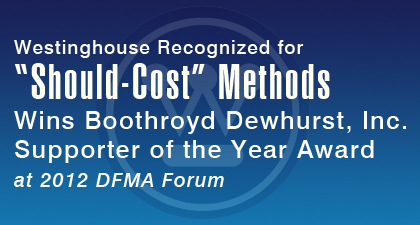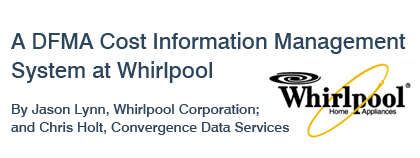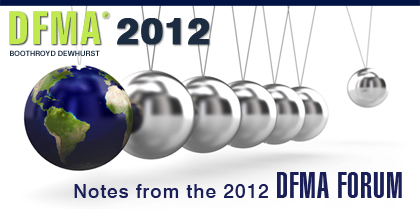

Looking back over the last four years, it’s not hard to notice which companies have flourished in the turbulent world economy. As I glance at the short list—Apple, Microsoft, Procter & Gamble, Caterpillar, Deere, Ford, Navistar and others—what they have in common are very well-designed products.
The other thing that they share is a dedication to R&D investment and early collaboration. Some of these companies made the 2012 Battelle/R&D magazine sponsored survey of key diversified manufacturers that spend big on research. The survey also showed that 81 percent of all manufacturing respondents were involved in some type of collaborative R&D activity with academia, outside labs or other companies. Sixty percent indicated that those collaborations were needed for future growth.
More companies are returning manufacturing to the U.S. from overseas these days. They feel they can do their best designs here, ship them faster, hold on to intellectual property, and meet cost expectations. Offshoring alone has not proven to be a silver bullet for growth.
Collaboration, R&D and, by extension, upfront design, are emerging as a winning formula.
Nick and I were invited to write for the August issue of R&D magazine about “How to build a better product.” We know from twenty-seven annual DFMA Forums what our customers’ recommendations would be. So we addressed the role of R&D departments in using DFMA to put science into the process of design and costing products.
As you have reported at the Forums, DFMA drives profits back into an organization, which then allows for greater concentration on improving functionality and speed to market. You can read our article by clicking here.
Each year, you are helping us document the benefits of DFMA product simplification and early costing. And you are helping each other map a better path through important approaches such as Lean, Six-Sigma, Value Engineering and Total Cost Management (TCM). Thank you!
John Gilligan


Receiving the “Distinguished DFMA Supporter of the Year Award” at the June 2012 DFMA Forum in Providence, RI, is Steven King (center), Westinghouse Electric Company’s (WEC) Global Director of Supplier Manufacturing and Value Engineering (SM&VE) group. Standing to King’s left and right are Boothroyd Dewhurst, Inc.’s President John Gilligan and Executive Vice President Nick Dewhurst. King accepted the award on behalf of his global SM&VE team.
Launched in only 2010, with a mandate to expand the role of Value Engineering (VE) into analytical costing, the SM&VE has used Design for Manufacture and Assembly (DFMA) software and methods to more effectively gauge product cost and complexity as early as the conceptual design stage. The team has had notable success. On a very challenging nuclear fuel component known as the Spider assembly, part count was lowered from 41 to 2 while improving manufacture and assembly. This reduced costs while also achieving stringent requirements for product quality, performance and durability.
The team plans to continue integrating DFMA with the company’s long tradition of VE. This effort will include training, collaborating with suppliers, and working with internal engineering teams and management to refine strategic costing practices and address evolving customer requirements.
The DFMA award has been given since 1993 for implementation success and for educating the community about the role that the methods play in creating highly competitive products.
“We are pleased to offer the Award this year to Steven and his entire team,” notes Gilligan. “They made a significant impact for their company, and very quickly, too.”
“In sharing their success at the Forum and in published articles,” said Dewhurst, “Westinghouse also gives others in the engineering field a chance to benefit. That’s a high standard met!”

The venerable energy company incorporates new tools into its design process to reduce complexity and lower costs.

Manufacturers of nuclear power plants operate in a unique sphere where design tolerances are razor-thin, safety requirements unrelenting, and standards for initial quality never bend. Yet even in an environment that values quality and safety above all else, cost has priority, too.
For Westinghouse Electric Company (Cranberry Township, PA), a leader in the nuclear power industry, meeting the challenge of cost control in the past sometimes involved as much art as science. As designers created products and sourcing managers negotiated prices with suppliers, the task of establishing what a product should cost often proved difficult. CLICK HERE for full story.

At Larson Davis, we recently completed the redesign of an outdoor preamplifier for our sound measurement products. Preamplifiers are used with our condensing microphones to reduce the extremely high impedance for transmission-to-signal analyzers. By using the Boothroyd Dewhurst DFMA® tool, we not only simplified the preamp design and optimized our part costs, but we beat an aggressive cost-reduction target of 75 percent from the existing preamp cost.
This paper shows how the DFMA® tool was used in our redesign to achieve these cost-savings and how far the cost reduction goal was exceeded.
A New Preamp at Larson Davis
Many engineers anticipate the opportunity to start work on a new design project, especially when there are technical challenges. The euphoria quickly fades and turns into despair when it is learned that a seemingly impossible cost target has been set as a condition for market success. This was the situation for a group of engineers at Larson Davis, a division of PCB Piezotronics, Inc. CLICK HERE for full story.

Whirlpool Corporation has significantly scaled their use of DFMA cost estimating tools in recent years. Today, there are several different teams and hundreds of DFMA users involved in cost modeling at the company. They support critical business functions including benchmarking, cost modeling for new and existing products, and supplier collaborations, to name a few. As a result, they created thousands of DFMA cost models and began to have difficulty with managing this data as well as in distributing it to large engineering groups and procurement teams for use in day-to-day business decision-making.
Whirlpool realized that the growth of the team and the increase in its usage of cost data within the business was beginning to stress the system. They needed a way to better to develop, manage, and reuse DFMA data they generate. As activity increased, the company also required a better reporting tool to help with distributing this information to end users in purchasing and engineering. They also needed to ensure cost models were created correctly and consistently, following standard procedures and use of DFMA libraries across international locations. Additionally, they had to more easily access this data, and conduct comparisons at different levels for components, assemblies and entire products. And lastly, the company needed a way to batch update past cost models against updated DFMA libraries. CLICK HERE for the full story.

This fall issue of DFMA Insights contains two papers from the 2012 Forum that you can read in full. Below, for a quick perusing, we’ve selected some “before and after” results for you to glance at, along with a few other highlights:
- Bill Devenish and Kevin Marett helped PCB-Larson Davis, an acoustics and vibration instrument company, beat aggressive 75 percent cost-reduction targets using DFMA tools and techniques. (See paper in this issue).
- Dynisco reported seven-figure savings just this year from its integrated Lean, Value Engineering, DFMA and Total Cost of Ownership (TCO) program. In the case of a housing assembly, designed initially by a contract firm, redesign efforts at Dynisco dropped part count from 62 to one.
- Bill Cleary of Westinghouse Electric Company reported that, by combining Value Engineering with DFMA, their teams were able to reduce part count for the Spider nuclear fuel assembly from 41 components to two, while achieving stringent requirements for quality, performance and durability. (See coverage in this issue).
- Rob Cole of Sonoco Protective Solutions (formerly Tegrant Corporation; Protexic Brands) identified reductions of 70 percent in housing parts and 90 percent in disassembly time for a computer workstation incorporating expanded polypropylene (EPP) materials. This DFMA-driven Electronic Packaging Assembly Concept (E-PAC) replaces the traditional PC chassis.
- Harry Moser of the Reshoring Initiative outlined the need for TCO analysis and spoke of successes to date. According to Moser at least 50,000 manufacturing jobs have been reshored, which is 10 percent of the 495,000 manufacturing jobs added since the low in January 2010.
- Whirlpool has introduced an enterprise system, with support from Convergence Data Services, to track and distribute DFMA and company cost models rapidly to its global departments. Whirlpool’s Competitive Cost Analysis (CCA) group is now comprised of 62 cost-engineering specialists who aid in benchmarking and competitive analysis. (See paper in this issue).
- Motorola Solutions global design centers have rolled out the Boothroyd Dewhurst DFA Index of efficiency to score past Best-in-Class product families against new products in development. The benchmarking program identifies opportunities for product simplification and excellence under a common metrics-based standard.
We welcome readers interested in the past 2012 Forum to ask us about papers and topics, or even open a discussion on LinkedIn about engineering questions you’d like addressed by the community.
(To look ahead at the 2013 Forum scheduled for June 13-14, please visit this link http://www.dfma.com/forum/index.html and be sure to check during the coming months for updates.)

The U.S. remains on top in manufacturing R&D investment with China closing in, says R&D magazine in its 2012 Global R&D Funding Forecast with Battelle. The U.S. holds 18 of the top 50 spots for worldwide R&D investment by public companies. Two-thirds of survey respondents indicated that in the U.S., federal tax credits and incentives should be central to government’s support of industry. A majority also said that return on investment in R&D is measured not just on profitability but in quality improvements and reduced product development costs, along with other less tangible factors. CLICK HERE

“How China Views the U.S. Manufacturing Renaissance.” Penned by IndustryWeek magazine, this article quotes China Daily journalist Zhang Monan on rising labor rates in that country (19 percent annually from 2005 to 2010) and gives her take on China’s narrowing advantage with the U.S.— and what the future holds for both trading giants. CLICK HERE.

High school is where it’s at! These ten high-school teen inventors are beyond amazing. Maryland’s Jack Andraka (fifteen years-old) has developed a pancreatic cancer test that is 168 times faster and 400 times more sensitive than current tests. California’s Marian Bechtel, also fifteen, has repurposed a metal detector and a tool for preventing bubbles in drying concrete to harness vibrations and sound waves in locating land mines. There are eight more accounts of student excellence in this article by Popular Science. CLICK HERE.

“Happiness First, Success Second,” sums it up in Quality Digest’s story about author Shawn Achor’s book: The Happiness Advantage: The 7 Principles of Positive Psychology That Fuel Success and Performance at Work. While we wince a bit at times in hearing such stock phases, Achor is all business when he describes the results of using praise and recognition with employees and colleagues. Team productivity increased 31 percent for one control group in his study—and in a relatively short amount of time. The bottom line: Positive reinforcement and an improved outlook make our thinking more efficient, broader and successful. CLICK HERE.
Home |
About BDI |
Contact Us |
Privacy Statement
Questions or problems regarding this site? Please Contact:
webmaster@dfma.com
Obtain technical support at support@dfma.com.
Want more info? info@dfma.com
DFMA and Concurrent Costing are registered trademarks of Boothroyd Dewhurst,
Inc.
© 2012 Boothroyd Dewhurst, Inc. All rights reserved.
If you would like to be removed from our mail list, please
CLICK HERE
DFMA Insights October 2012